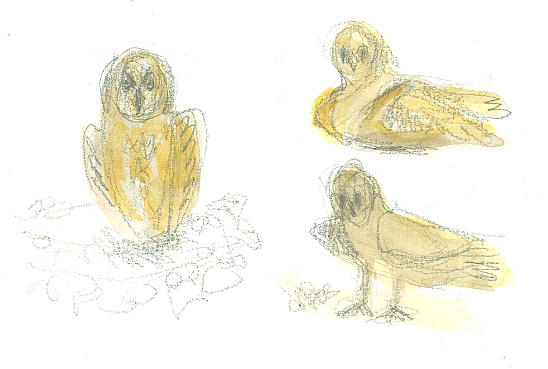The Galapagos Islands are a part of the South American country of Ecuador, and 600 miles west from the mainland. The sixteen islands and surrounding waters are under strict conservation regulations and require a special visa to visit. The week-long tour we took was on the 96-passenger ship Endeavor II, operated by the team of National Geographic and Lindblad Expeditions. Everybody we met on the boat was very committed to learning about the place. They weren’t just there for the ride. (But the ride, and the food, and the people were spectacular.)
The islands are directly south of Louisiana, USA, and in the Central Time Zone. Right on the Equator. As a side note, the currency since 2000 of Ecuador is the US Dollar, rate 1:1.
We visited the islands colored orange. Other boat tours visit the western islands too. The tour operator sometimes offers a deal on sticking around after one tour and signing up for the other one.
The islands are all of volcanic origin. The hotspot that feeds them remains stationary, deep in the earth, while the surface plate is slowly moving toward the east. So the far western islands are still volcanically active, while those to the east have cooled down, established their own ecology, and those even farther east have begun to erode and disappear.
Seven ocean currents converge in this area, one from Antarctica and others from warmer climes. Each occasionally brought with it a few members of a local species, somehow entangled in bits of branches or other floating vegetation. With luck they found mates and settled on whatever island they ended up at. They then began a long, long period of trying to exist there. Some of them made it and evolved to optimize a life in that ecosystem; others probably couldn't handle it and disappeared.
Examples of Galapagos evolution include the shortest penguins in the world, at about 1.5 feet tall. They don’t need to be any taller because they do most of their hunting underwater and don’t do much walking upright.
Another animal that evolved is a bird, the cormorant. It too moved to an existence where most of its food came from under water, so it no longer needed wings suitable for flying, and over time they shrunk to near uselessness.
Two different examples of how evolution didn't just work to enhance positive features, but it also favored reduction of no longer needed ones that simply absorbed excess energy that could better be put to use elsewhere.
The first evening on the ship, this sunset caused us all to ooh and aah, snap photos, and if you are me, sketch. I’m sure they planned it that way. The sunlight burst through the two gaps in the dramatic rock formation known in English as Kicker Rock. We were informed that the sun sets every night at 6:30, year round.

And the colors continued. The land on the horizon is San Cristobal Island.

Gardner Bay on Espanola Island. Yes, I sat in the sand and painted the sea lions as they napped, rolled over, swatted flies, and nursed from their mommies. We learned that they expend so much energy catching their breakfast that they snooze for most of the rest of the day. We have even seen them asleep on park benches in well populated areas. Everybody keeps their distance.
Our floating home is off to the left. Snorkelers and a Zodiak are in the turquoise water, just right of the center.
We took a hike on Espanola Island just before sunset. I sketched quickly when we stopped briefly. Gianna, our naturalist, explained everything in sight, as it was all new to us. A lighthouse, a cairn, a sea lion seeking shade, an iguana sunbathing to warm up, and a mocking bird in a prickly bush.
And more on the hike. A pelican silhouetted in the fading light. An iguana seeking shade to cool off, a colorful crab, and another bird—maybe a finch.
It was stunning to us, considering our background of having lived in Maryland, to see live red crabs. Live crabs in Maryland are blue, and they only turn red when steamed. These red crabs were amazingly mobile, able to jump quite a distance from rock to rock.
And our first sighting of Nazca boobies—the boobies with the grey-green feet, not the more famous blue-footed ones. And their new babies, who look just like balls of cotton fluff.
The law in The Galapagos is that you must maintain a six foot separation from any wild animals. It was a challenge when we came across a sea lion asleep in the middle of a narrow trail.

Every morning I pushed aside the cabin’s curtains to see what was out there. On this day, Floreana Island. It was not particularly comfortable painting while kneeling on the bed, but I persisted.

The black rubber rafts, called Zodiacs, ferried people to and from the white beach. Some landings were ‘dry’, at a dock, while others were ‘wet’. Wear appropriate footwear and wade ashore!
The lower image is Champion Island. We had options of snorkeling, a glass-bottomed boat tour, and Zodiac tours around the second island. My first sighting of blue footed boobies was here.

Another inspiring end of day view from the top deck. Post Office Bay is on the far right.
Next up, Santa Cruz Island. In the town of Puerta Ayora is the Charles Darwin Science Center for the study of the giant tortoises. And the successful attempts at re-population of some species. So a lot of baby tortoises were crawling about in their separate enclosures.
Even as I write this there have been reports of new discoveries of evolutional significance.
In one enclosure, these two types of tortoises were right next to each other. It was perfect viewing to compare the shell shapes. The guy on the left has a low, round shell, good for marching through heavy foliage and finding vegetation close to the ground. The fellow on the right evolved his (or her) shell shape on a different island where the vegetation is higher off the ground. So a longer neck is required, and an arched shell is also needed to give the neck ample room to move. You would not see these two in a natural state on the same island.
After the visit to the science center we got a ride into the town of Puerto Ayora. My feet stopped moving when I got to this cemetery right next to the narrow street. Owls were painted on the high stucco wall. There’s a belief locally that owls help send our souls to heaven. A guide told us that a competition decides who gets the privilege of painting a new design.
And soon after that, I couldn’t get past this mosaic gate of a dragon, without opening my sketchbook. A lovely acacia tree blooms on the right.
Next up, the town fish market. All of the fish seemed to be pink, which was colorful next to the blue water of the harbor. Two pelicans are waiting for scraps. Sea lions pushed and shoved here too for fish heads but they didn’t make it into my drawing for some reason.
Then two, or was it three, buses took us to the Highlands, the hilly, tree-shaded top of Santa Cruz Island.
We visited a family farm where we saw sugar cane squashed into juice, and the juice boiled. Soft cheese cubes dipped into liquid brown sugar syrup were a delicious treat. Then came the fiery sugar cane liquor.
Before all that we saw the family coffee beans pounded to remove a husk, then roasted over a fire.
After cheese, sugar, and alcohol at the farm, it was time for lunch. We had a lovely al fresco meal at the Aquelarre Restaurant. The building, in the cool of the Highlands, was full of art and old bottles in the windows. The Chilean owners were most friendly.
A hibiscus bloom and some ginger blossoms from the gardens at Aquelarre.
We stayed on an extra hour in the town of Puerta Ayora before returning to the ship. I took the time to sketch the end wall of the local kids’ skate park. I love all the large sea creatures painted by the young people who use the park. The black lizards were nearby on the sidewalk. I thought they would slither away, but they posed nicely for me.
I often copy children’s art.
Another view of a pretty place, Dragon Hill on the other side of Santa Cruz Island from the town. The trees along the top give it scale.
The top is Guy Fawkes Island. The bottom is just labeled ‘Zodiac wake’ in my sketchbook.
In the lounge area of the ship were a coffee machine, hot water, and a selection of tea bags. It is entertaining to draw small things. They are part of the experience.
Also in the lounge were a bar and late afternoon yummy snacks. I finished my paintings in the lounge. And we saw several science related films in the area too. It was just a great hang out spot for the week.
One Zodiac, and four quickly drawn kayaks. The kayaks had just been put into the water in preparation for an afternoon activity.
Another island, another shape to capture in the sketchbook. Most islands in the Galapagos are uninhabited, by people. They abound in birds and reptiles.
On our last day we hiked on Genovesa Island. The ship anchored in a caldera (sunken volcano peak), and we climbed up a steep set of roughly cut rocks called Prince Philip’s Steps. The top of the island is flat and home to a million birds we were told. It certainly was a believable number. We kept to a narrow path, and we saw nesting bird families within three feet.
In my drawing, a red footed booby and a Nazca booby. The red footed ones, with the blue and pink heads, have evolved to have a thumb, sort of, and can roost on a low branch.
Celso, our naturalist for the hike, said we had to look very closely to see a short eared owl as they are exactly the color of the lava rocks. He was right. But we did spot two of them. This is three drawings of the same one.
My accordion sketchbook painted on the beach on Bartolomé Island.
Just for fun, and because a few people requested it, I gave an art talk on the last evening on the ship. I showed the drawings and paintings I had done that weekend in my sketchbook. Before I spoke, the ship doctor played his guitar and sang.
After my talk, a visiting photographer did splendid magic tricks.
Once back on the mainland, we took a tour of the city of Guayaquil. Highlights were a flower market seen from the bus, a city park full of tree climbing, striped iguanas, a view of a park along the waterfront, and a walking tour of an old part of the city that merges into a very new part. I drew this view of an old hillside neighborhood of the city, called Cerro del Carmen, from our hotel window.
And here is what is probably the most well known animal in the Galapagos, the blue-footed Booby.

 .
.






























What a trip! And what a treasure for your children and grandchildren! I enjoy the detail and the commentary...please know what a fan I am of your endearing pictures.
ReplyDelete